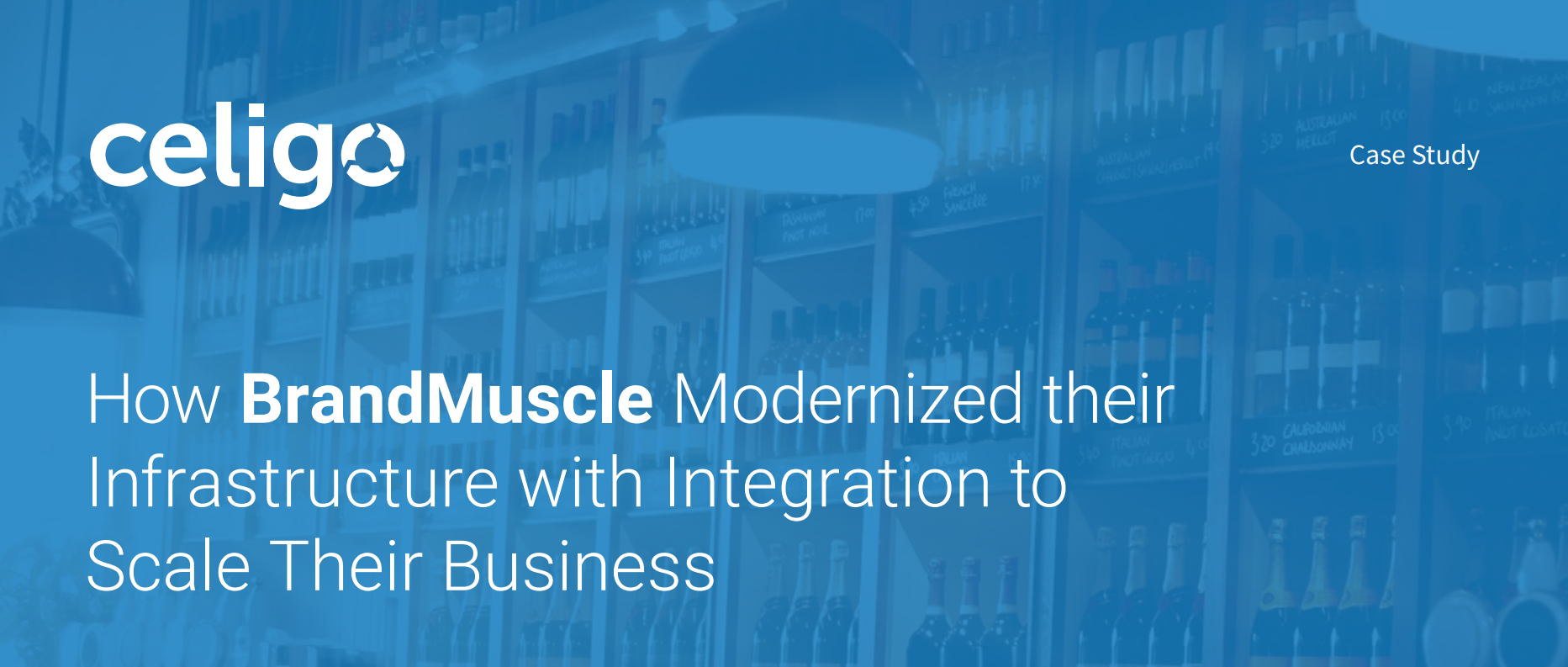
How BrandMuscle Modernized their Infrastructure with Integration to Scale Their Business
Customer: BrandMuscle
Product: Integrator.io
Website: brandmuscle.com
“We’re doing close to $40 million dollars worth of transactions going through these five integration points. we had one mistake on an order in October, when previously we were running anywhere between 20 and 50 any other month.” - Ryan Elkins Chief Financial Officer Brandmuscle
About BrandMuscle
BrandMuscle is the leader in integrated local and channel marketing, serving over 300 of the world’s top brands. The BrandMuscle Integrated Local Marketing Platform, Brandbuilder, enables brands and their local marketing partners to deliver the greatest marketing impact to each individual customer to acquire and retain the best customers, build loyalty, enhance lifetime customer value, and maximize ROI.
“We have two different types of revenue streams. We have one from basically our media side which will be newspaper ads and billboards and radio spots and events,” says Randy Elkins Chief Financial Officer at Brandmuscle. “And our other side is really a lot of print media where we have a couple of print shops where we’re printing out posters, wall clings and the big surfboads you’ll often see in the corner of bars.” The combination of these two revenue streams makes BrandMuscle about a $100M in revenue, annually.
Background
“Our big push in 2018 was to get NetSuite up and running as the new ERP system and retire both our MAS 500 system and our old media buying software,” explained Brian Kuntz, Director of Corporate Solutions Delivery at BrandMuscle. With the decision to modernize their core technology backend, BrandMuscle needed to rethink how everything was done. They enlisted the help of Sikich and Mark Goodson, Partner in Charge of the NetSuite practice at Sikich.
“The two older systems talked together nicely because everything was onsite, and all we had to do was write SQL queries. With removing MAS 500 and replacing it with NetSuite, we have a cloud-based solution,” says Brian. “Mark and the Sikich team were able to help us out in creating custom code for our media buying.” This version of Netsuite needed to interact with their own homegrown solution, BrandBuilder, and push data back and forth.
The Challenge
Brian continues, “We were moving a lot of data via SQL query, so we had to redesign our SQL queries into API calls.” Going through the process with Mark,” says Brian Kruntz, “We would key in an opportunity, then review it, then somebody would key it into an order and review it. Finally, somebody would key it into an invoice.”
There was a lot of reliance on manual intervention because the customer facing data forms didn’t collect everything needed to move things to the next step. “There were a lot of users on our side that had to re-key data, and because of multiple screens there were multiple places to make mistakes,” explains Brian.
In addition to forcing large amounts of manual data entry, the old systems were fragile and running on 2003 technology. “There were a lot of times where we had somebody working up to 70 hours in a week just to make sure things were moving the way they should,” says Brian.
The Solution
“Celigo is pretty intuitive. Once I was able to take a look at the JSON example and spend some time playing around, I was able to get things up and running. The whole middleware is through Celigo and it works very well.” - Brian Kuntz Director, Corporate Solutions Delivery Brandmuscle
The first goal was to get Netsuite implemented and “talking” to a number of other systems in the BrandMuscle tech stack. “ Having the Sikich team and their expertise help us through the entire process was instrumental to our success,” says Brian. “We did a big requirements gathering that basically wrote the roadmap of everything that we needed to complete.”
In addition to having Sikich help implement Netsuite, BrandMuscle implementedthe Celigo integrator.io platform to move data to and from Netsuite to their proprietary solution, BrandBuilder. “We were able to create our media requests inside of NetSuite, push them over to BrandBuilder then push an opportunity back over to NetSuite. We work the opportunity as a sales order inside of NetSuite and generate the invoice to push back over for payment in BrandBuilder and then push the payment into NetSuite,” explains Brian. “There’s a lot of back and forth using API, JSON, FTP, a little combination of everything. The whole middleware is through Celigo and it works very well.”
With Celigo in place, it is not necessary for the BrandMuscle team to rekey data anymore and everything runs faster. Prior to making the change to Netsuite and Celigo, data would take over a couple of hours due to the manual input. Now the data goes every 15 min. “As part of this effort, we redesigned our forms to allow the customer to key in the actual orders on BrandBuilder, therefore reducing the amount of data entry by our users and minimizing errors. We are able to take the data from one stage to another stage without having to rekey the data- even on the invoice side,” says Brian.
BrandMuscle spent about three months planning and designing the new flows because they wanted to get it right the first time. They did not want to risk inconveniencing their customers or lose any data. This was a significant challenge given the scope of the changes they were making. Mark Goodson explains, “We wanted to follow all of the best practices” Mark continues, “so we started this project with our BPA, business process assessment, which was really the road map and solution design taking about a month to complete.”
With the NetSuite implementation in the hands of Sikich, Brian took it upon himself to do the initial integration work. “For the first round, I took it upon myself to get a lot of the integrations working. I have since passed the torch to other people on my team since a business analyst could very easily use this tool,” explains Brian. “It was pretty intuitive and within 30 to 60 days, I felt very comfortable using the tool.”
Looking past the initial integrations, Brian also used development resources to do some more advanced integrations. “I can also send this to a developer to do some most advanced stuff which I don’t feel comfortable doing,” says Brian. “We have JSON returns now.” Brian and his team of four developers are responsible for implementing and updating all of the Celigo flows. They are constantly looking at ways to automate additional processes and take things to the next level.
BrandMuscle is using integrator.io in other places too. They also use it to populate their data mart. “We have a data mart for our clients to be able to do some analytics with our Insights Team,” says Brian. “We have saved searches that automatically go out there in the middle of the night to populate the data mart and do everything we need to do inside that data mart with the NetSuite data.” Additionally, there are a number of FTP integrations with Salesforce Marketing Cloud to display information for their customers. Going forward, “we’re looking to integrate with some of our vendor APIs to be able to send POs and receive invoices from them,” says Brian. “We have a lot of things that we’ve done, and we have a lot of things that we still want to do with this product.”
With Celigo integrator.io in place, it is not necessary for the BrandMuscle team to rekey data anymore and everything runs faster.
The Bottom Line
“One pretty amazing stat is that we had one mistake on an order in October, when previously we were running anywhere between 20 and 50 any other month,” says Ryan. Considering October was their first month in production, “to have only one error is impressive, and it had nothing to do with the system. Somebody keyed something wrong, so I think it’s already paying tremendous dividends just in something like that,” states Ryan.
Brian estimates they are already moving about $40 million dollars worth of transactions through the five order to cash integrations. Brian says, “There’s probably about 10 to 12 places using Celigo to interface with our software stack. By the end of this project, we’ll have anywhere between 45 and 50 integrations.”
By eliminating the need to re-key and automating more processes every month, BrandMuscle is able to redirect resources to making their product better. “Celigo takes nowhere near the amount of care and maintenance that we had to do in the past”, explains Brian. Those resources are now focused on “advancing the product that we offer rather than fixing it.” Brian goes on to say, “it’s a nice reprieve for them to work on the product rather than building scripts to integrate two pieces of software. I think everyone’s pretty happy with the solution.”
“There are about 10 to 12 places where we’ll be using Celigo to interface with our software stack. By the end of this project, we’ll have anywhere between 45 and 50 integrations.” – Brian Kuntz Director, Corporate Solutions Delivery Brandmuscle
About Celigo
Headquartered in San Mateo, Celigo is pioneering the future of application integration. Celigo’s SmartConnectors™ are prebuilt integrations that connect independent SaaS applications together seamlessly. These connectors are backed by the integrator.io, an easy-to-use integration middleware platform for building custom integrations.
Contact Us for more information on Celigo for your Business.
Copyright © 2025 - Custom Software Solutions, Inc.







